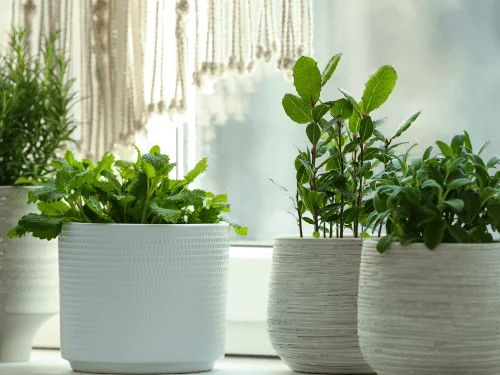A Complete Guide to Growing Chamomile

1. Can windowsill plants improve indoor air quality?
Yes, several houseplants, including snake plants, pothos, and spider plants, are known for their air-purifying abilities, removing toxins such as formaldehyde and benzene from indoor air. While plants won’t replace proper ventilation, they do contribute to improved air quality and add natural humidity to dry indoor environments.
2. How can I keep my windowsill plants healthy in winter?
During winter, light intensity decreases, and indoor heating can dry the air. Place your plants on windowsills with maximum sunlight, avoid overwatering, and increase humidity using a tray of water or a small humidifier. Sensitive flowering plants like geraniums or African violets may benefit from supplemental grow lights to maintain bloom and foliage quality during shorter winter days.
3. Can I grow flowering and foliage plants together on the same windowsill?
Yes, but pay attention to their light and water requirements. Group plants with similar needs—sun-loving succulents together and shade-tolerant foliage like snake plants and pothos separately. This prevents overwatering or underexposure and ensures all plants thrive. Rotating flowering plants occasionally can also help blooms develop evenly.
Can mango trees be grown in pots?
A: Yes, potted mango trees require large containers with well-draining soil. Regular repotting and sunlight exposure are essential to grow a healthy mango tree in a pot.
Can mango trees grow indoors?
A: Yes, young mango trees can grow indoors in large pots with sufficient sunlight or grow lights. Indoor mango trees may take longer to flower and fruit but are manageable with proper care.
How do I grow mango trees from seed faster?
A: Using warm conditions, consistent moisture, and polyembryonic seeds can speed up germination. Grafting onto seedling rootstocks is another method to grow mango trees faster and ensure quality fruit.
When do mango trees produce fruit?
A: Grafted mango trees may bear fruit in three to five years, while seed-grown trees may take five to eight years. Flowering and fruiting are influenced by climate, sunlight, and proper mango tree care.
1. How long does it take for daisies to bloom?
Plants grown from seed may take several weeks to produce their first flower buds. Most daisy plants will start to bloom in early summer, and with deadheading, they can produce a third blooming later in the season. Shasta daisies and oxeye daisies are especially reliable bloomers that can flower continuously throughout the season if given care tips such as fertilizing and proper watering.
2. Can daisies be grown in pots?
Yes! Potted plants are ideal if you have limited garden space. Make sure the pot has drainage holes and use well-draining garden soil. Daisies are also happy in containers if they get enough hours of full sun. Remember to monitor moisture: avoid too much moisture at the bottom of the pot.
3. What are the best companion plants for daisies?
Daisies pair well with bee balm, echinacea, and zinnias. These companion plants share similar sunlight and watering needs, helping your garden flourish throughout the season. They can also create a beautiful mix of single or double flowers alongside bright white petals of daisies.
If you're a tea lover, you've likely experienced the soothing magic of chamomile. But did you know that growing your own chamomile is surprisingly easy, even for beginners? Imagine stepping into your garden to pick fresh chamomile flowers whenever you want to brew a calming cup of tea.
This complete guide will walk you through everything you need to know to cultivate your own chamomile haven, from planting seeds to harvesting those beautiful, daisy-like blooms. Whether you have a spacious backyard or a sunny windowsill, growing chamomile is a rewarding way to enjoy this beloved herb.
Perfect Conditions for a Happy Chamomile

- Sunlight: Chamomile thrives in full sun, soaking up at least six hours of direct light each day. In particularly hot climates, you can give it a bit of afternoon shade to protect it from intense heat.
- Soil: This herb prefers well-draining soil that's rich in nutrients. If your soil is heavy clay or sandy, mix in some compost to improve its texture and fertility. Chamomile likes slightly acidic to neutral soil, ideally with a pH between 5.6 and 7.5.
- Water: Consistent moisture is key, but don't drown your chamomile! Aim for about an inch of water per week, adjusting depending on rainfall and temperature. Check the soil with your finger; if it feels dry an inch below the surface, it's time to water.
- Temperature: Chamomile is a cool-weather lover, happiest when daytime temperatures are around 60-70°F (15-21°C). It can handle some heat, but in very warm climates, providing afternoon shade can help it stay healthy.
Planting Your Chamomile

1. Choose Your Planting Method
- Seeds (Indoors): Starting seeds indoors gives you a head start. This is ideal if you have a shorter growing season or want to ensure a strong start for your chamomile plants.
- Seeds (Outdoors): Direct sowing outdoors is simpler but requires a bit more patience as the seeds germinate. This is a great option if you have a longer growing season and plenty of space.
- Seedlings: Buying seedlings is the fastest way to get your chamomile garden going. This is perfect if you want quick results or if starting seeds seems daunting.
2. Prepare Your Planting Site
- Location: Choose a spot that gets at least six hours of sunlight per day. If you live in a hot climate, some afternoon shade can be beneficial.
- Soil Preparation: Loosen the soil to a depth of about 12 inches. Mix in compost or other organic matter to improve drainage and fertility. If your soil is heavy clay, add some sand to help it drain better. If it's sandy, add some compost to help it retain moisture.
3. Plant Your Chamomile
- Seeds (Indoors):
- Fill seed trays or small pots with seed-starting mix.
- Moisten the soil.
- Sprinkle chamomile seeds on the surface of the soil. Do not cover them, as they need light to germinate.
- Gently press the seeds into the soil.
- Cover the trays or pots with plastic wrap to create a warm, humid environment.
- Place the trays or pots in a warm location with indirect sunlight.
- Keep the soil moist but not soggy.
- After about 7-14 days, the seeds should germinate.
- Once the seedlings have developed their first set of true leaves, you can transplant them to individual pots or outdoors after the last frost.
- Seeds (Outdoors):
- After the last frost, scatter the seeds over the prepared soil.
- Lightly rake the soil to cover the seeds.
- Water the area gently.
- Thin the seedlings to 8-12 inches apart once they are a few inches tall.
- Seedlings:
- Dig holes that are slightly larger than the root ball of the seedlings.
- Space the holes 8-12 inches apart.
- Gently remove the seedlings from their containers and place them in the holes.
- Fill the holes with soil and gently firm it around the base of the plants.
- Water the seedlings well.
4. Water and Mulch
- Water: Water your chamomile regularly, especially during hot, dry periods. Aim for about an inch of water per week.
- Mulch: Apply a layer of mulch around the plants to help retain moisture, suppress weeds, and keep the soil cool.
Caring for Your Chamomile
.webp)
- Pruning: Deadhead (remove) spent flowers to encourage more blooms. After the main flowering period, you can cut back the plants by about a third to promote bushier growth.
- Winter Care: In mild climates, chamomile may survive the winter without much fuss. In colder areas, mulch around the plants to protect their roots from frost. If you're growing chamomile in pots, you can bring them indoors for the winter.
Harvesting Your Chamomile Bounty

1. Timing is Key
- Look for: Fully open flowers with petals that are lying flat, not drooping down. The center of the flower (the yellow disk) should be slightly raised.
- When: Harvest in the morning after the dew has dried, but before the sun gets too hot. This helps to preserve the essential oils that give chamomile its fragrance and benefits.
2. Gather Your Supplies
- A clean pair of scissors or pruning shears.
- A basket or container to hold your harvest.
3. Pick with Care
- Locate: Find a flower that meets the criteria above (fully open, flat petals, raised center).
- Grasp: Gently hold the stem of the flower just below the flower head.
- Snip: Use your scissors or shears to cut the stem just below the flower head.
- Repeat: Continue harvesting until you have enough flowers for your needs. Be sure to leave some flowers on the plant to ensure continued blooming.
Troubleshooting Common Issues

- Aphids: These tiny insects can suck the sap from your plants. If you see them, blast them off with a strong spray of water or use insecticidal soap.
- Spider Mites: These pests can also weaken plants. Increase humidity by misting the plants, and use insecticidal soap or neem oil if needed.
- Powdery Mildew: This fungal disease shows up as a white, powdery coating on leaves. Ensure good air circulation by spacing plants properly and remove any affected leaves.
FAQs: Frequently Asked Questions
Q: Is chamomile easy to grow from seed?
A: Chamomile is an easy-to-grow herb that thrives in the garden. You can start chamomile from seed indoors or sow them directly in the ground during the spring. Both common chamomile and German chamomile grow in similar conditions and are easy to care for.
Q: When should I plant chamomile, and when should I harvest chamomile flowers?
A: The best time to plant chamomile is in the spring after the last frost. You can harvest chamomile flowers throughout the summer and fall as they bloom. Pick chamomile flowers with yellow centers and white petals when they are fully open.
Q: What are the best tips for how to grow chamomile in my herb garden?
A: Chamomile likes full sun and well-draining soil. It's a great companion plant for many vegetables and herbs. To care for chamomile, ensure it has enough water and deadhead the flowers to encourage new buds. Chamomile plants can quickly become invasive, so it's important to control their spread.
Q: Can I grow chamomile indoors?
A: Yes, you can grow chamomile indoors! Start chamomile seeds in a pot that is at least 6 inches deep and place it in a sunny location. Make sure the soil stays moist and well-drained. Young chamomile plants can also be transplanted into larger pots.
Q: How do I use chamomile? Can I make chamomile tea with homegrown chamomile?
A: Chamomile is used for various purposes. The daisy-like flowers with white petals and yellow centers can be used fresh or dried to make soothing chamomile tea. Chamomile flowers can also be used to make tinctures, salves, and other natural remedies. Homegrown chamomile makes delicious tea! Simply steep a few fresh or dried flowers in hot water for a relaxing cup of chamomile tea.




